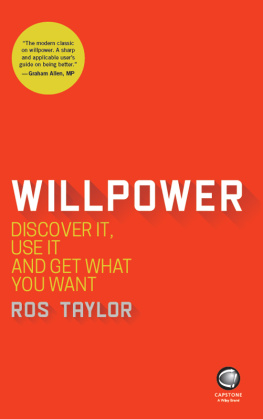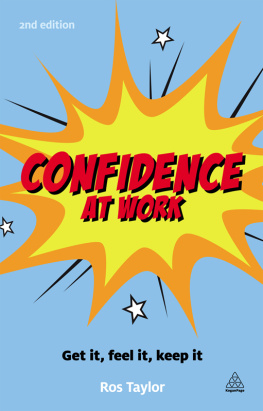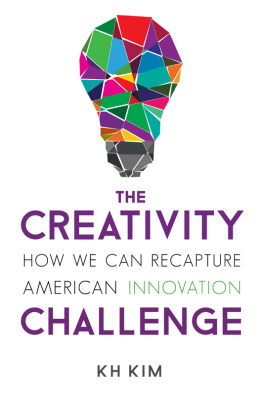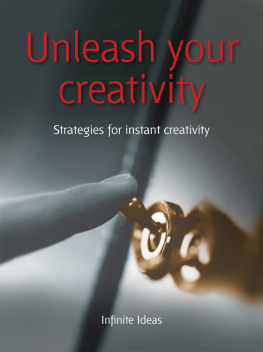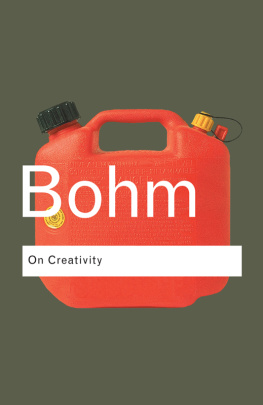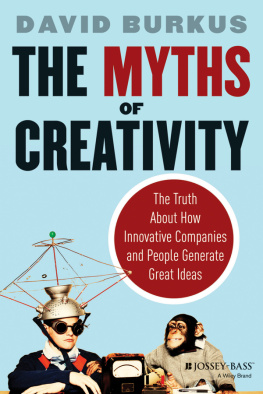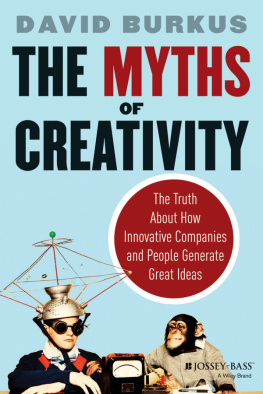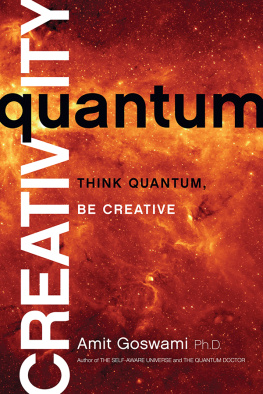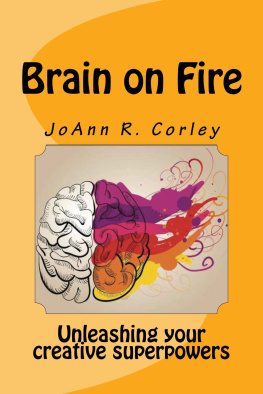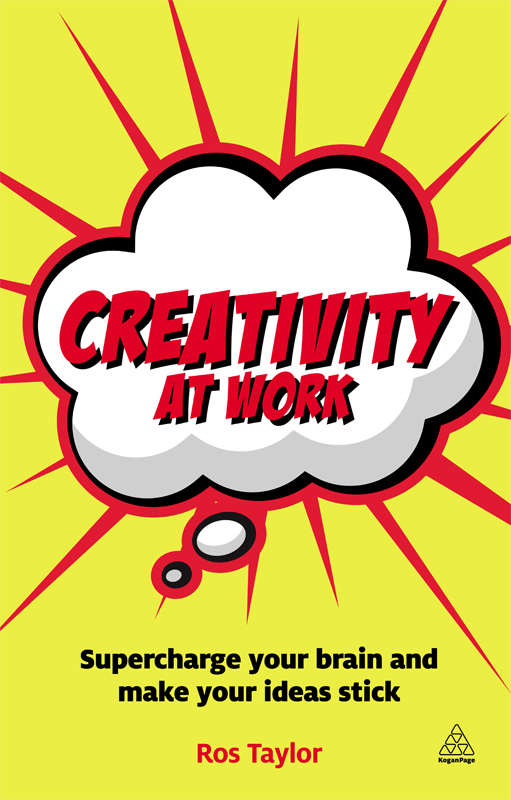Note on the Ebook Edition For an optimal reading experience, please view large
tables and figures in landscape mode. |
This ebook published in 2013 by
Kogan Page Limited
120 Pentonville Road
London N1 9JN
UK
www.koganpage.com
Ros Taylor 2013
E-ISBN 9780749466671
This book is dedicated to my husband John Young who has supported me throughout the writing of this book, especially during our holiday in France. I must also thank my friends whose responses are in the book or who suggested wonderful work creatives for me to interview.
Contents
I certainly never thought of myself as creative. I sang and performed in opera but I didnt paint or compose or direct. That to me was true creativity. I certainly didnt see my work as a psychologist as remotely creative despite having to plan therapeutic programmes for each patient I saw.
Creativity was someone else, somewhere else. My partner at the time was gloriously creative, writing books on entrepreneurship and producing musicals. By comparison I felt unworthy. He discovered the Creative Problem Solving Institute in Buffalo, home to Osborn and Parnes, the creators of brainstorming and the creative method. He would return from conferences with wonderfully wacky ideas. He told the story of a very large man with a very small triangle that he would strike intermittently and when you heard the ting you had to blurt out the first thing that came into your head. The aim of this was to jolt people out of their entrenched thoughts. It all sounded impossibly romantic and out there and not for the likes of me!
That relationship came to an end and I left Scotland to work in London. That summer I decided to go to Buffalo and experience the tings for myself. I never did meet the large man with the small triangle but I did encounter some marvellous people and experiences. I have Sufi danced, painted large murals, danced with Brazilians, sung eight-part harmony with people who have never sung before and listened to the most creative speakers the world has to offer. In addition to these artistic experiences I also learnt about problem solving and how individuals and teams can come up with ideas whenever they require them. I began to understand how I was creative and what my unique offering is to the world of work. I also came to realize just how important ideas were to the lifeblood of a company and organization.
If there were ever a time that we require to do things differently it is now. I know in my own business, which focuses on leadership development and executive coaching, that many companies at times of financial challenge have less money to spend or just stop buying. So it has been up to all of us in our company to come up with different ways of delivering and unique ways of differentiating us in the marketplace.
Dr Richard Florida is one of the worlds leading experts on economic competitiveness, demographic trends and cultural and technological innovation. He claims that developing the full human and creative capabilities of each individual, combined with institutional supports such as commercial innovation and new industry, will put us back on the path to economic and social prosperity. Like Richard, I think most people would agree that creativity at work is a good thing. What with the recession, more people out of work and fewer jobs to go round, doing things differently would be right at the top of an organizations agenda you might think. But is it?
There are a number of paradoxes around at the moment. Politicians talk about the UK being a knowledge economy based on innovation, but it doesnt seem to have had an impact so far on our recovery. And why has the government cut back its research centres by 60 per cent if the priority right now is on innovation? Talking to clients, the word is that a focus on short-term shareholder value has created less time for creativity and doing things differently, not more. In addition the dodgy capitalism of the sort we have seen recently in banks may have reduced the appetite for the risk of new ways or new products.
However, I knew none of these things for certain. So I decided to find out with a mixture of 100 one-to-one interviews, online questionnaires and a more formal poll of 1,000 working people in the UK. I wanted to learn what they thought about creativity at work, what it looked like on the ground. I wanted to cut through the rhetoric and get down to what happens every day in companies and organizations that are faced with a changing customer base and volatile markets. Do employees feel empowered to come up with new ideas and are they rewarded for their input? Are HR departments hiring creative board members to move this creativity agenda forward? Did teams have a creative process so that they could produce ideas or solve problems swiftly and effectively?
I also discovered that there have been a number of myths about creativity that I think I had succumbed to myself:
- Creative people are eccentric personalities who are different from the rest of us.
- Creativity is really about the arts and has no place in everyday life and certainly not in either business or the professions.
- Creativity is a mysterious process that cant be studied as ideas come out of the blue with no traceable path.
- The greatest creativity comes from people working on their own, witness Archimedes and Sir Isaac Newton.
- It might be OK for the Googles of this world that have money to throw at creativity but not me in my small business.
These myths have been challenged by a robust body of research spearheaded by Teresa Amabile, Professor at Harvard Business School. But has this information percolated down to where it matters at the coal face of business? And what does creativity mean to a cross-section of business people and is their definition of creativity different from that of an artist? What do people do in organizations every day to harness ideas for business improvement? Can we learn anything from artists, designers or photographers who have to be creative for a living?
In this book I share my journey with you to find answers to these questions in the hope that you will take up the challenge of becoming even more creative than you are at the moment. It has taken longer than I thought as I kept discovering fascinating insights from neurology, psychology and business. The starting point really is that you cant be innovative at work without having creative ideas. When I started this enquiry I thought they were one and the same, a tautology. But I now know that they are not. Creativity is the precursor to innovation, the practical result creativity made manifest.
So to begin I wanted to know if other leaders, consultants and artists were clear in their definition of what creativity is. I really like to see the whites of the eyes when I am researching a topic so out of the many respondents to an online questionnaire I circulated to our database, I chose 100 people from different sectors and countries and carried out telephone and face-to-face interviews. The open-ended questionnaire I used for these interviews follows in of this book for you to complete so that you understand your contribution to creativity.
I then delved into the literature to see what happens in the brain. I wanted to know if creative thinking is different from other kinds of thinking and, if so, can this be measured and understood? I spent so long reading and delving that I had to be prised away to write this book. I began to wonder if my 100 people were a representative sample of attitudes to creativity at work so I put together a survey comprising 14 questions that look at three major areas of creativity at work: the resources organizations put into creative effort, the processes used to obtain new ideas, and finally the culture of an organization and how .


